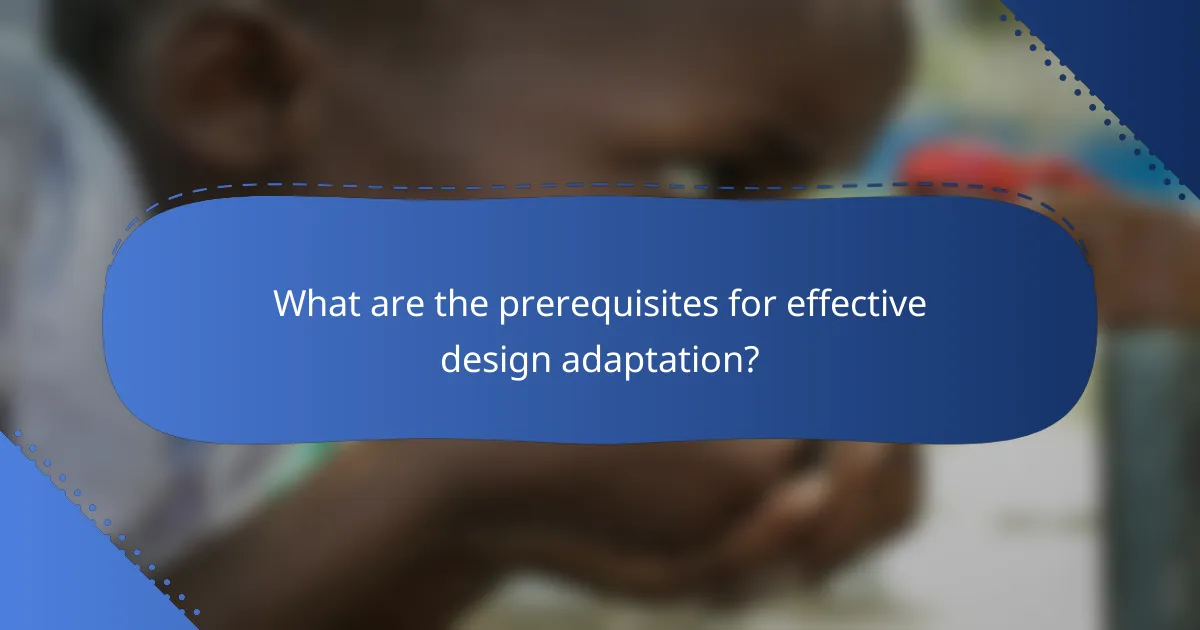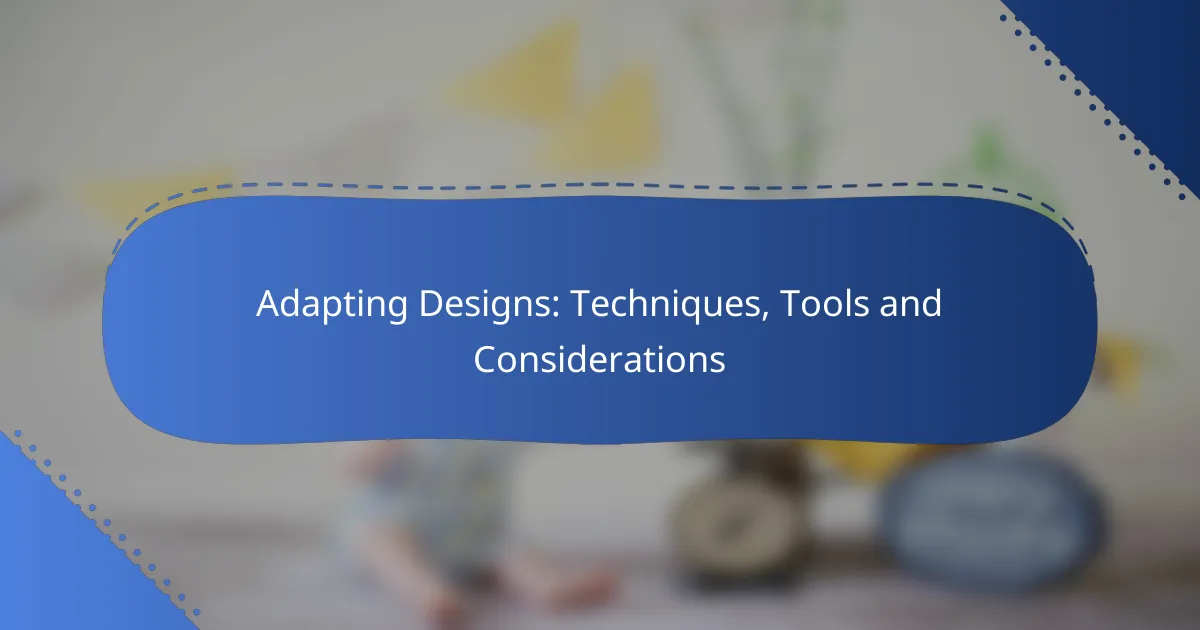Adapting designs effectively is crucial for ensuring that digital products provide a seamless user experience across various devices and screen sizes. This process involves optimizing layouts, content, and functionality to meet the specific context of users. Utilizing the right tools can streamline design adaptation, enabling collaboration and iteration based on user feedback. Additionally, key considerations such as accessibility and consistency play a vital role in enhancing usability and overall user satisfaction.

What are effective design adaptation techniques?
Effective design adaptation techniques ensure that digital products function well across various devices and screen sizes. These methods focus on optimizing user experience by adjusting layouts, content, and functionality based on the user’s context.
Responsive design
Responsive design is a technique that allows web layouts to adjust fluidly to different screen sizes and orientations. By using flexible grids, images, and CSS media queries, designers create a seamless experience across devices, from desktops to smartphones.
Key considerations include testing designs on multiple devices and ensuring that content remains accessible and visually appealing. Avoid fixed-width layouts, as they can hinder usability on smaller screens.
Mobile-first design
Mobile-first design prioritizes the mobile experience when creating digital products. This approach involves designing for smaller screens first and progressively enhancing the experience for larger devices.
By focusing on essential features for mobile users, designers can streamline content and improve load times. This technique often leads to better performance and user satisfaction on all devices.
Modular design
Modular design breaks down interfaces into reusable components or modules. This approach allows for greater flexibility and consistency across different parts of a project, making it easier to adapt designs for various contexts.
When implementing modular design, ensure that each component is self-contained and can function independently. This strategy simplifies updates and maintenance, as changes to one module can be easily reflected across the entire design.
Adaptive design
Adaptive design involves creating multiple fixed layouts tailored to specific screen sizes. Unlike responsive design, which fluidly adjusts, adaptive design detects the user’s device and serves the most appropriate layout.
This technique can enhance performance by delivering optimized content for each device type. However, it requires more initial planning and development effort to create and maintain multiple layouts.
Progressive enhancement
Progressive enhancement is a strategy that focuses on delivering a basic experience to all users while providing advanced features to those with better capabilities. This ensures that essential content is accessible regardless of the user’s device or browser.
To implement this approach, start with a solid foundation of HTML and basic functionality, then layer on CSS and JavaScript enhancements. This method promotes inclusivity and can improve overall site performance, especially for users on slower connections.

Which tools aid in design adaptation?
Several tools are essential for design adaptation, each offering unique features that streamline the process. These tools facilitate collaboration, prototyping, and design iteration, making it easier to adjust designs based on user feedback or project requirements.
Adobe XD
Adobe XD is a powerful design tool that allows for rapid prototyping and design adaptation. Its features include responsive resizing, which automatically adjusts design elements when the screen size changes, making it ideal for creating adaptable layouts.
Additionally, Adobe XD supports collaboration through real-time co-editing and sharing options, enabling teams to work together seamlessly. Users can also integrate plugins to enhance functionality, such as accessibility checks or design systems.
Figma
Figma is a cloud-based design tool that excels in collaborative design adaptation. Its real-time collaboration features allow multiple users to work on a design simultaneously, making it easy to gather feedback and make adjustments on the fly.
Figma’s component system enables designers to create reusable design elements, which can be easily updated across multiple screens. This feature is particularly useful for maintaining consistency in design adaptations across various platforms.
Sketch
Sketch is a vector-based design tool popular among UI/UX designers for its simplicity and efficiency. It offers powerful features for design adaptation, such as symbols and shared styles, which allow for quick updates across projects.
While Sketch is primarily Mac-based, it integrates well with various plugins that enhance its capabilities, including tools for user testing and design handoff. However, teams working remotely may find its collaboration features less robust compared to cloud-based alternatives.
InVision
InVision is primarily a prototyping tool that allows designers to create interactive mockups of their designs. It supports design adaptation by enabling users to test and iterate on designs based on user interactions and feedback.
InVision’s integration with other design tools like Sketch and Adobe XD allows for a smooth workflow, making it easier to adapt designs as needed. Its commenting feature also facilitates communication among team members, ensuring that all feedback is captured and addressed during the adaptation process.

What considerations should be made for user experience?
Key considerations for user experience include ensuring accessibility, integrating user feedback, and maintaining consistency across platforms. These factors significantly impact how users interact with designs, affecting usability and satisfaction.
Accessibility standards
Accessibility standards are essential for creating inclusive designs that cater to users with diverse needs. Familiarize yourself with guidelines such as the Web Content Accessibility Guidelines (WCAG), which provide criteria for making digital content more accessible to people with disabilities.
When designing, consider elements like color contrast, text size, and keyboard navigation. Aim for compliance with at least Level AA of WCAG, which is widely recognized and often required by law in many jurisdictions.
User feedback integration
Integrating user feedback is crucial for refining designs and enhancing user experience. Collect feedback through surveys, usability testing, or direct user interviews to understand pain points and preferences.
Actively implement changes based on this feedback, prioritizing the most common issues. Regularly revisiting user input can help ensure your design evolves with user needs and expectations.
Cross-platform consistency
Cross-platform consistency ensures that users have a seamless experience regardless of the device or operating system they use. This involves maintaining similar design elements, navigation structures, and functionality across all platforms.
Utilize responsive design techniques to adapt layouts for different screen sizes. Regularly test your designs on various devices to identify inconsistencies and make necessary adjustments, ensuring a cohesive user experience.

How do design adaptations impact display advertising?
Design adaptations significantly enhance display advertising by tailoring visuals and messages to resonate with target audiences. These adjustments can lead to better user experiences, ultimately influencing engagement and conversion rates.
Improved engagement rates
Adapting designs can lead to improved engagement rates by making advertisements more relevant and appealing to viewers. For example, using localized imagery or language can create a stronger connection with the audience, encouraging them to interact with the ad.
Consider A/B testing different design elements, such as colors, fonts, and layouts, to determine which variations capture attention more effectively. Engaging visuals that align with user preferences can increase click-through rates by significant margins.
Higher conversion rates
Higher conversion rates often result from effective design adaptations that guide users toward desired actions. Simplifying the user interface and ensuring clear calls to action can make it easier for potential customers to complete purchases or sign up for services.
Incorporating trust signals, such as customer reviews or security badges, within the design can further enhance credibility and encourage conversions. Regularly analyzing performance metrics will help identify which design strategies yield the best results, allowing for continuous improvement.

What are the prerequisites for effective design adaptation?
Effective design adaptation requires a clear understanding of the target audience and thorough market research. These elements ensure that designs meet user needs and align with market trends, enhancing overall effectiveness.
Understanding target audience
To adapt designs successfully, it’s crucial to identify and comprehend the target audience. This involves analyzing demographics, preferences, and behaviors to tailor designs that resonate with users.
Consider creating user personas that represent different segments of your audience. This can help in visualizing their needs and expectations, guiding design choices that enhance user experience.
Market research
Conducting market research is essential for understanding the competitive landscape and identifying trends. This process involves gathering data on competitors, industry standards, and consumer preferences.
Utilize surveys, focus groups, and online analytics to collect insights. Aim to identify key features that appeal to your audience, which can inform design adaptations that stand out in the market.

What are common challenges in adapting designs?
Common challenges in adapting designs include resource limitations, varying user needs, and technological constraints. These factors can significantly impact the effectiveness and feasibility of design adaptations.
Resource limitations
Resource limitations refer to constraints in budget, time, and personnel that can hinder design adaptation efforts. When resources are tight, prioritizing essential features over nice-to-have elements becomes crucial to ensure that the core objectives are met.
For example, if a project has a limited budget, it may be necessary to focus on adapting designs for the most critical user segments first. This approach allows for a phased implementation, where feedback can be gathered and adjustments made in subsequent iterations.
To navigate resource limitations effectively, consider creating a checklist of essential features and functionalities. This helps in identifying which adaptations can be made within the available resources, ensuring that the design remains user-focused while staying within budget constraints.
